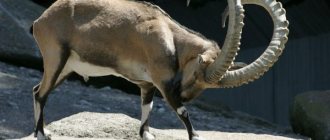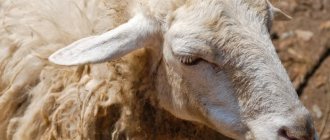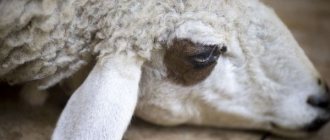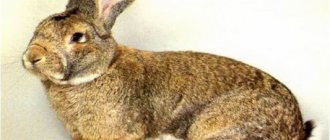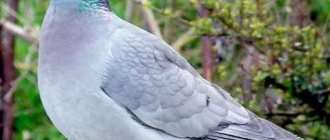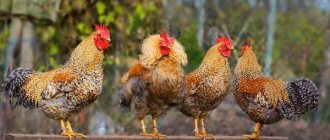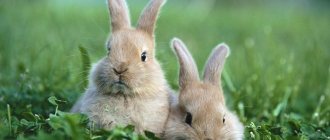The domestication of sheep occurred around 10 thousand years BC. Over the entire period of breeding, a huge number of sheep breeds have been developed. Each of them differs in the direction of productivity, exterior and physiological characteristics, as well as in adaptability to certain living conditions.
In Russia today, about 60 different breeds of sheep are successfully kept. However, in some farms there is a “erosion” of the characteristics of the breed. This happens due to non-systematic selection work. As a result, “landmark breeds”, unfortunately, do not always have the best breed characteristics. Therefore, an obligatory condition for preserving breed qualities is the annual grading of sheep and selection work.
____________________________________________________________________________________
Sheep products are presented
| Mutton | Wool |
| Milk | Sheepskin |
| Kurdyuk | Smushki |
____________________________________________________________________________________
Sheep farming is the most diverse type of livestock farming in terms of productivity. All productivity indicators are influenced by many factors:
- sheep breed,
- animal age,
- feeding,
- content.
Some indicators of sheep breeding productivity
____________________________________________________________________________________
| The profitability of a sheep breeding enterprise is impossible without the sale of lamb. Therefore, meat productivity is characterized by the slaughter weight of animals. On average, rates vary from 35% to 60%. | The main criterion for assessing the wool productivity of animals is the annual wool clipping. This figure can vary from 3 to 15 kg, depending on the characteristics of the breed and the conditions of keeping the sheep. |
____________________________________________________________________________________
Sheep milk has always been valued for its valuable qualities:
They do not receive milk from meat-fat breeds, fine-fleece and semi-fine-fleece sheep. The milking period directly depends on the length of time the lamb is kept under the ewe. For example, weaning occurs on the 4th day. Consequently, the milking period can reach up to 4-5 months. | Sheepskin is the skin removed from a sheep. In addition to the Romanov breed, the sheepskin area of other breeds must be at least 19 dm2. The skin is removed from the animal at the age of 5-7 months. Coat length is an important evaluation criterion. The length of the wool is above three cm - classified as wool fur sheepskin; from one to three cm: for half-wool; from 0.5 to one cm: for short-haired. There are 3 types of sheepskin.
|
____________________________________________________________________________________
Dairy breeds
The breeding of such animals is aimed at the subsequent production of fermented milk products and cheese. Although this is not the main goal. Initially - obtaining meat and fur. Sheep milk is nutritious and has beneficial properties. It is recommended to be used for bone diseases and for the prevention of cancer.
To get 30 kg of cheese, you will need 100 liters of sheep's milk.
Tsigaiskaya
The Tsigai species has a strong build, a long body with strong, well-positioned limbs, and a small oval head. The animals have an even spine, a large chest in girth, and a long and skinny tail. The weight of a ram is up to 100 kg, and that of a ewe is up to 50 kg. Traditionally they are white. The fertility of this cattle is average. The meat and fur are of fairly high quality.
Due to their high milk productivity, they can be bred to produce milk. During 12 weeks of lactation, a ewe can produce from 41 kg to 120 kg of milk with a fat content of 7.5-8%. Bryndza, Roquefort cheese, and kachkaval are made from it.
East Frisian
Livestock of this breed is valued for its good milk yield. It is characterized by large size, the weight of an adult individual reaches 90 kg. The body is straight, slightly curved. There is no hair on the head of a rounded-oblong type, a strong and massive chest. The pet has a long tail without fur. They come in white and black-brown colors. The udder is large, the nipples are powerful and well developed. The breed is suitable for being alone in a household.
During the lactation period, a ewe is capable of producing from 600 to 700 liters of milk, the fat content of which is 5–8% and the protein content exceeds 5%.
Sheep breeding direction
Classification of breeds occurs in accordance with economically useful indicators. Due to the variety of types of directions, they are distinguished: fine wool, semi-fine wool, semi-coarse wool, coarse wool.
____________________________________________________________________________________
| Fine-wool direction | This type is rightfully considered the main one. Almost all fine-wool sheep in Russia are often called Merinos. The Soviet Merino, Transbaikal and Stavropol sheep breeds have become widespread. What is common to fine wool is the composition of the wool with the highest percentage of fluff, excellent wool quality, the release of a large amount of grease, the wool itself is homogeneous and has a fiber diameter of up to 25 µ (0.025 mm.). It is worth noting that there are 3 main areas of fine-fleece sheep breeding, which differ from each other in the ratio of wool produced and live weight. This is expressed in the ratio of live weight (in kilograms) and wool clipping (in grams). According to this principle, 3 directions are distinguished (however, there are fine-fleece rocks that occupy an intermediate position and are not included in the directions listed below):
|
| Semi-fine-fleece direction | Representatives of this direction in the Russian Federation can be called Tsigai and Gorno-Altai. They are bred to obtain wool of 58 - 32 quality, which is characterized by a heterogeneous fleece composition (fluff and transition fiber), thickness up to 65 microns, average fiber length - 18 cm. |
| Semi-coarse-haired direction | Breeds of this direction include Saradzhinskaya and Tajik. Individuals of this breed are sheared from 3 to 5 kg of semi-coarse wool (down, passing fiber and a small percentage of awn), which is used in the manufacture of high-quality carpets. |
| Coarse-haired direction | This direction supplies raw materials:
The most productive and widespread representatives of this type in our country are the Edilbaevskaya and Romanovskaya breeds of sheep. The consequence of long-term selection work was an increase in multiple births, improvement in the quality of wool and precocity of individuals. Which, of course, was an incentive for the mass breeding of these breeds, as the most profitable and productive. |
____________________________________________________________________________________
Meat breeds
The products that domestic sheep provide are high-quality meat and tender, healthy lard. The meat-greasy species is about 1 m tall and has long legs. Thoroughbred individuals are distinguished by the presence of a fat tail, which contains fat. It is located in the area of the sacrum, oval or rounded. In some breeds the weight can reach up to 30 kg.
Gissarskaya
Today this is the largest species in terms of size and live weight. The Hissar breed has a strong base, well-developed muscles, a massive chest, an impressive back and a large skull. The fat tail is raised sublimely. Its dimensions reach 35–40 cm in width and 40–50 cm in length. The hair is coarse, hard, dark red or black, and is of no value. The head is brown, the legs are the same color.
The weight of the Gissar species can reach 190 kg, the height at the withers is 80 cm. The meat yield when slaughtering an average ram is at least 60% of the total weight. Each sheep produces up to 40 kg of fat. These pets have good milk production. From one ewe you can get up to 120 liters of milk in 60 days. The fertility of females is low, and the survival rate of lambs is 100%.
Edilbaevskaya
The breed is distinguished by its correct physique. The Edilbaevskiy species is large, sheep reach 90 cm at the withers, and can be up to 1 m in girth. Rams weigh up to 160 kg, and females up to 100 kg. The colors of animals are red, brown and black. Mammals have no horns and drooping ears. The large fat sac on the rump increases as the pet ages.
After slaughter, the meat yield is about 55% and at least 12 kg of fat is obtained from the fat tail. The fertility of ewes is low, but the milk production during lactation is quite good - up to 150 liters. The high fat content of milk (5.8%) makes it possible to produce fermented milk products. The value of the Edilbaevsky breed is in the speed of reaching productive age.
Fine wool wool direction
| Sheep of this direction are distinguished by the maximum wool shearing (at least 60 grams) per 1 kilogram of live weight. Fine-wool sheep are distinguished by thick wool, highly developed skin and bones, but poorly developed muscles and adipose tissue. Also a difference can be considered the folding of the skin with characteristic 1-2 folds of skin on the neck or a burdock. Average weight of rams: 85 kg; sheep: 46 kg. Average weight of ram fleece: 16 kg; sheep: 7 kg. One of the characteristic representatives of the wool trend is the Soviet Merino breed. | Sheep breed Soviet Merino |
____________________________________________________________________________________
Selection of sheep breeds in the direction of sheep breeding
In Russia today, about 60 different breeds of sheep are successfully kept. However, in some farms there is a “erosion” of the characteristics of the breed. This happens due to non-systematic selection work. As a result, “landmark breeds”, unfortunately, do not always have the best breed characteristics. Therefore, an obligatory condition for preserving breed qualities is the annual grading of sheep and selection work.
| Fine-wool direction | This type is rightfully considered the main one. Almost all fine-wool sheep in Russia are often called Merinos. The Soviet Merino, Transbaikal and Stavropol sheep breeds have become widespread. What is common to fine wool is the composition of the wool with the highest percentage of fluff, excellent wool quality, the release of a large amount of grease, the wool itself is homogeneous and has a fiber diameter of up to 25 µ (0.025 mm.). It is worth noting that there are 3 main areas of fine-fleece sheep breeding, which differ from each other in the ratio of wool produced and live weight. This is expressed in the ratio of live weight (in kilograms) and wool clipping (in grams). According to this principle, 3 directions are distinguished (however, there are fine-fleece rocks that occupy an intermediate position and are not included in the directions listed below):
|
| Semi-fine-fleece direction | Representatives of this direction in the Russian Federation can be called Tsigai and Gorno-Altai. They are bred to obtain wool of 58 - 32 quality, which is characterized by a heterogeneous fleece composition (fluff and transition fiber), thickness up to 65 microns, average fiber length - 18 cm. |
| Semi-coarse-haired direction | Breeds of this direction include Saradzhinskaya and Tajik. Individuals of this breed are sheared from 3 to 5 kg of semi-coarse wool (down, passing fiber and a small percentage of awn), which is used in the manufacture of high-quality carpets. |
| Coarse-haired direction | This direction supplies raw materials:
The most productive and widespread representatives of this type in our country are the Edilbaevskaya and Romanovskaya breeds of sheep. The consequence of long-term selection work was an increase in multiple births, improvement in the quality of wool and precocity of individuals. Which, of course, was an incentive for the mass breeding of these breeds, as the most profitable and productive. |
Fine wool wool and meat production
| Fine-fleece sheep for wool and meat production yield 1 kg of pure wool. live weight ranges from 40-50 grams. These sheep are larger in size (and sometimes in live weight) compared to wool sheep. Meat forms are well expressed. There are fewer skin folds. Average weight of rams: 110 kg; sheep: 58 kg. Average weight of ram fleece: 12 kg; sheep: 5 kg. The Altai breed of sheep can be called a prominent representative of the wool and meat industry. | Altai breed of sheep |
____________________________________________________________________________________
Zoological classification
It is built according to the length and shape of the tail. It was these elements that reflected differences in breeds. The length of the tail is determined by the tip, more precisely by its relation to the hock joint. And the shape is based on the level of formation of fat deposits along the caudal vertebrae.
| Groups | Description of differences in breeds |
| Kurdyuchnaya | Underdeveloped, very short, of 5–6 vertebrae with fatty deposits at the root of the tail |
| Short-fat tailed | Short, fat deposits around caudal vertebrae, number of vertebrae 10–12 |
| Long-fat-tailed | Long, with fat deposits of different constitutions, vertebrae 22–24 |
| Short-skinny-tailed | Skinny, of 10–12 vertebrae |
| Long-skinny-tailed | Skinny, of 20–22 vertebrae |
| Anurans | No tail |
Fine wool meat-wool direction
| Meat-wool fine-fleece sheep shear wool does not exceed 40 grams per 1 kg. live weight. A clear distinguishing feature of this type is the absence of skin folds and a characteristic “barrel-shaped” body. The backbone is moderate, the meat forms are well defined. Average weight of rams: 95 kg; sheep: 60 kg. Average weight of ram fleece: 7 kg; sheep: 4 kg. One of the characteristic breeds of the meat and wool direction is the Prekos. | Prekos breed of sheep |
____________________________________________________________________________________
Fur-meat breeds of coarse-wool sheep
| Meat production was the original purpose of raising sheep. Lamb is an easily digestible meat, with a specific smell that is given to it by fat. Hence the pattern: the more fat there is in a sheep, the stronger the smell of meat will be. The most common breed in the Russian Federation is the Romanov breed. Sheep are early maturing, have high fertility, body weight and are characterized by excellent meat and wool productivity (the famous Romanov sheepskin coats). | Romanov breed of sheep |
____________________________________________________________________________________
Meat breeds
If the purpose of raising sheep is to obtain meat, then you need to choose meat species. They are distinguished by their unpretentiousness, rapid growth, large size, fleshy body, and good yield of meat products. They are characterized by high fertility and early maturity. The resulting raw materials are of excellent quality; there is practically no fat in the meat.
Texel
This breed is considered the best in the world gene pool. The rams are large, proportionate in build, very hardy and not picky about feeding. Sheep have semi-fine, white fur without black fibers with a lot of grease. The head and legs are not covered with hair.
The meat is juicy, delicate texture, and has its own taste. It does not have a pungent odor or greasy, greasy taste. Texel meat productivity reaches 60%. The weight of adult rams and females is up to 125 kg. Texels are used to improve the productivity of other breeds because when crossed they pass on the best qualities. The fertility of the species is about 150%.
Dorper
These are large rams with well-developed muscles of the back and thighs on short legs. The skull is small, slightly cubic in shape with medium-sized ears, the muzzle and neck are short. The dignity of the species in the thighs of animals is the main source of raw materials of the sheep. Dorpers are white with a black colored head and upper neck. Pets are characterized by precociousness and rapid weight gain.
Since the fat in the muscle tissue of a sheep is evenly distributed, when slaughtered, dietary meat is obtained with a yield of up to 60 kg. The raw material has a mild taste and delicate texture. It has no specific smell.
Buubey
Bred on the territory of Buryatia. Buubey fully corresponds to its climatic conditions. They tolerate hot summers and frosty winters well, and are able to feed on pasture while maintaining good productive performance. The main feature is the rapid weight gain and high quality of lamb. Sheep have an elongated body, a strong back, a broad chest, long legs and a short tail.
Buubey ewes are fertile. Up to 3 lambs can be born at one time. By 7 months, due to the high milk production of the female, the lamb weighs about 40 kg.
Meat and fat breeds of coarse-wool sheep
| In meat-fat sheep, fat is deposited in the tail area in a special way, which is highly valued as a separate livestock product and is widely used in economic activities. Such sheep belong to the fat-tailed type. As a rule, all representatives of this type of sheep gain weight well, have low fertility and are not whimsical. The most widespread is the Edilbaevskaya breed of sheep. | Edilbaevskaya breed of sheep |
____________________________________________________________________________________
Sheep breeds
Sheep breeds are classified depending on specific tasks according to one of two systems: zoological or production.
Zoological classification.
It is built not according to the differences in the skull, as in other farm animals, but according to the shape of the tail and its length. This classification is explained by the fact that the size and shape of the tail, to a much greater extent than the skull, was reflected in the differences between groups of sheep in terms of a set of biological characteristics. The length of the tail, according to this classification, is taken into account not in absolute linear values, but by whether the tip of the tail reaches the hock joints or falls below. Tail shape is characterized by the degree of development of fat deposits along the caudal vertebrae and the appearance of these deposits. The zoological classification of sheep was developed by the famous naturalist Pallas. Some changes were made to it by the German scientist Nathusius.
Subsequently, a number of additions to the Pallas-Nathusius classification were made by Russian scientists - first N.P. Chirvinsky, and then M.F. Ivanov. Based on the length and shape of the tail, sheep breeds are divided into the following five groups. Due to the great variability in the number of tail vertebrae, as well as the shape and size of fat deposits on the tail, especially in the process of breed formation using crosses of individual breeds, using this classification it is not always possible to clearly establish the difference between sheep of different breeds, and even more so between different crosses. Nevertheless, zoological classification has scientific significance, since it allows us to judge the degree of biological similarity or difference between sheep of different breeds. And this must be taken into account in the practice of using breeds, when zoning them and choosing them for crossings. However, within the same zoological group there are often breeds that are very different in terms of productivity. For example, the group of long-lean-tailed sheep includes fine-wooled breeds, meat breeds, some smooshkovye, and various other coarse-wooled ones. Therefore, for production purposes, zoological classification alone is not enough. It is supplemented with production (economic) classification.
Industrial classification.
Production classification reflects the direction of sheep productivity. It was developed by academician M.F. Ivanov. Proposing this classification as more convenient for production, he at the same time noted its certain convention.
The fact is that there are cases when sheep of the same breed in different areas are bred for different purposes. For example, sheep of the Tsigai breed in Moldova and especially in the countries of the Balkan Peninsula are used as milk-wool animals. The dairy products of Tsigai sheep play an important role in the nutrition of the population there.
In most regions of Ukraine, the Rostov region, the Lower Volga region and Kazakhstan, these sheep are bred only for the purpose of obtaining wool and meat, and their milk has no commercial value and, as a rule, is not used as a food product. However, in most breeds the main direction of productivity is expressed quite clearly. Therefore, the production classification is successfully used at the present time with additions and changes made to it in accordance with the development of sheep breeding, the creation of new and improvement of existing breeds. In relation to modern requirements for sheep products, all sheep breeds bred in the Soviet Union are divided into the following groups
Breed zoning of sheep. More than 60 breeds of sheep and several breed groups are bred in Russia. There are more than 600 different breeds in the world's sheep resources. An important condition in sheep breeding is the scientifically based territorial placement of such breeds, the breeding of which in specific natural and economic zones meets the objectives of producing the corresponding sheep products.
Conservation and use of indigenous and local breeds. The intensive development of fine-fleece and semi-fine-fleece sheep breeding in our country, caused by new socio-economic conditions, has led to a significant reduction in the number of coarse-wool sheep. Some breeds of rough-wool sheep or their offspring are on the verge of extinction or have already been lost.
These include Volosh, Bakur, Cherkassy, Kulundinsky, Reshetilovsky, Chushka, Malich, Imeretian and others. In this regard, the preservation and restoration of valuable indigenous breeds has become very important.
It is known that most domestic cultural breeds were created on the basis of coarse-wool sheep. In addition, these breeds have a relatively recent history of origin and therefore are not yet distinguished by high constancy. In this regard, breeders strive to consolidate the achieved positive traits and eliminate undesirable qualities. This direction of selection leads to increased homogeneity of the herd and, consequently, to a decrease in genetic variability. With a high degree of constancy, animals can lose very important properties acquired from local coarse-haired breeds - endurance, resistance to diseases and adaptability to extreme conditions. In such cases, it may be necessary to resort to backcrossing with the original coarse-haired breed.
In recent years, in all zones of the country, sheep breeding has been transferred to an industrial basis, which necessitates large capital investments. Only those breeds of sheep from which a wide variety of products can be obtained can justify the costs and increase the efficiency of sheep farming under these conditions. For this purpose, new breeds are created or existing ones are improved in the direction of increasing wool and meatiness, fertility and early maturity, as well as paying for feed with products. To increase the efficiency of fattening, industrial crossing with meat-and-wool breeds is used in herds of late-ripening sheep to produce early-ripening young stock. To solve these problems, many scientists and specialists use not only cultivated, but also indigenous breeds. As an example, we can refer to the experience of France and Bulgaria, where multiparous breeds are being created with the participation of Romanov sheep imported from the Soviet Union. The Gissar breed, whose animals are distinguished by their outstanding precocity, can be used for industrial crossing in certain regions of Central Asia and Kazakhstan.
The value of native breeds, as already noted, is due to their resistance to disease. Thus, Karachay sheep, thanks to certain morphophysiological characteristics, easily adapt to unfavorable conditions of the highlands (humid climate, temperature changes, sharply rough terrain, high altitude above sea level - 3-3.5 km). Therefore, only native breeds can effectively use pasture areas located in areas with extreme conditions.
Meat and wool breeds of coarse-wool sheep
| Sheep of this type are distinguished by good wool productivity and a relatively large build. Wool shearing can reach 8 kg. At the same time, meat productivity is inferior to other areas. This largely explains the small number of sheep today. Mostly small farms are engaged in breeding. One of the representatives is the Mikhnov breed of sheep. | Mikhnovskaya breed of sheep |
____________________________________________________________________________________
Smushkovye breeds of coarse-wool sheep
| Smushkas are fur pelts with a bizarre fur pattern (curl). They are obtained from premature or newborn lambs. It is worth noting that meat, milk, sheepskins and wool can be obtained from smooshkov sheep. The Karakul breed of sheep is especially popular and holds a well-deserved leadership in this area. | Karakul breed of sheep |
____________________________________________________________________________________



